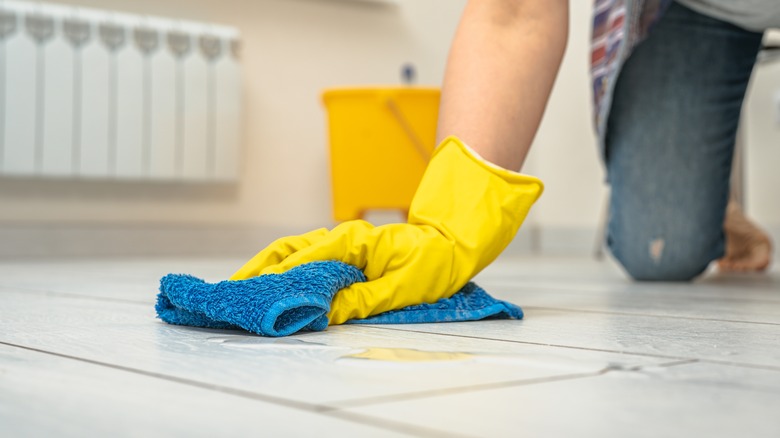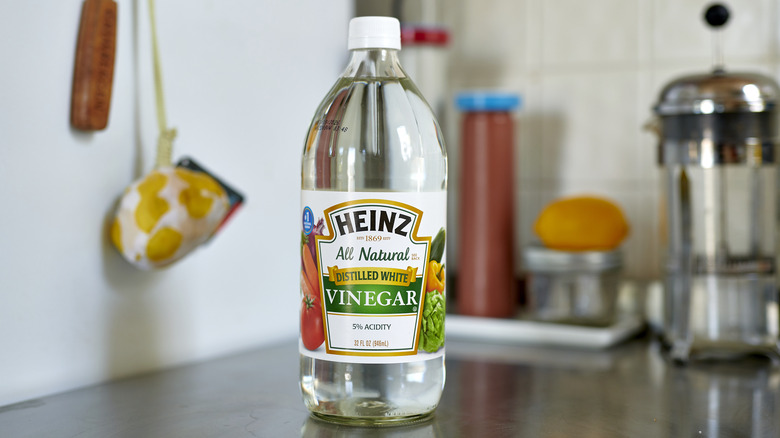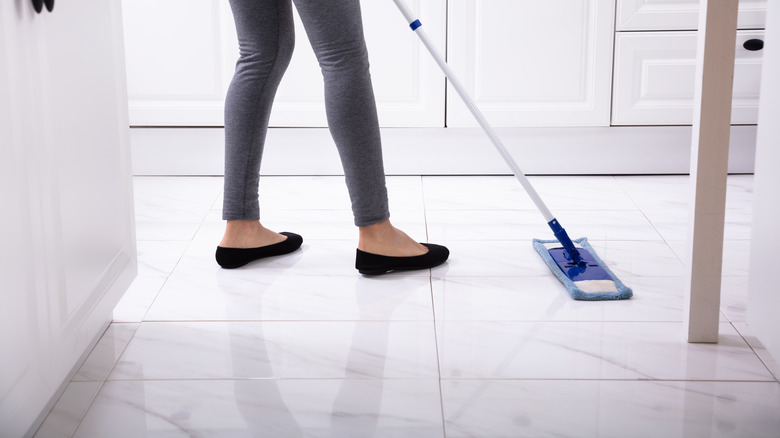The Common Household Ingredient That Works Wonders On Dirty Porcelain Floors
One of the main reasons people choose to install porcelain tile flooring is because it's so durable. While slightly more expensive than its ceramic cousin, it's also a lot denser and baked at a higher temperature, making it more resistant and hardwearing. These, of course, are great qualities for flooring. Not only do you not have to worry about scratches or chips, but you also don't have to worry about damaging it with most cleaning products. Unlike natural stone alternatives like marble or slate, porcelain can handle most cleaning solutions you throw at it, including acidic ones. That's why when these floors get grimy and need a stronger cleaning solution to polish them, vinegar is the thing to reach for. This common household ingredient will help break down dirt and restore the floor's shine.
Vinegar is great to use for porcelain tile maintenance because it's natural, inexpensive, and widely available. Rather than spending upwards of $10 on specialty cleaners, you can get a 1/2 gallon of distilled vinegar for $3. It's also available at any grocery store or big box retailer, and won't bomb your bathroom or kitchen with harsh chemical smells. Here is why vinegar is the best cleaner to use on your porcelain tile floors.
How to clean porcelain floors with vinegar
This cleaning hack is recommended by tile experts and cleaning companies, so it's a safe bet to use. However, you don't need to utilize this method weekly. Instead, it's enough to vacuum or sweep your tiles weekly, and then deep clean them with vinegar once a month. To do so, fill a bucket with 1 gallon of warm water and 1/4 cup of vinegar. You want to avoid using undiluted vinegar on your tiles since it can be too strong for the finish to handle. It can begin to wear it down, eventually stripping it after repeated exposure. Mop the floor with the diluted version, and then rinse it clean by using water from a fresh second bucket.
This vinegar mixture is also safe to use on grout and can help you lift any discoloration or wipe away mildew. For this part, you want to carefully pour some undiluted vinegar into the grout lines, and let it sit for about 10 minutes so the acid can break down the dirt or gunk trapped inside. Then, use a toothbrush or sturdy grout brush to scrub the lines, wiping it clean with a damp cloth as you go so it doesn't settle back into the grout.
Why it works
Vinegar is an ideal cleaning solution for porcelain tiles thanks to the acetic acid in it. It eats away at everything from dirt to mineral deposits to grease to soap scum, which is made possible by its low pH level. Store-bought bottles of vinegar can have a pH as low as 2.2. For context, a neutral pH is 7. The way it works is that the acid breaks down the molecular structure of these messes, making it easier to wipe them away with water.
It's also an effective floor cleaner because it has antibacterial properties. Floors can house all sorts of pathogens and bacteria, whether they're tracked in by shoes, pet paws, or naturally unsanitary areas like the toilet. Using vinegar as a cleaner can help mitigate some of that worry. For example, according to the scientific journal BMC Microbiology, it can neutralize E. coli and Salmonella. By cleaning your floors with vinegar, you can be rest assured neither of those bacteria are hiding on your floors.


